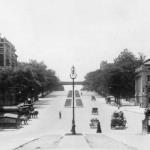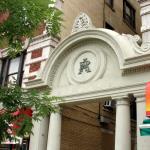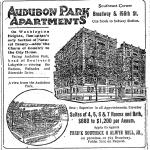 | ||||
Broadway (The Boulevard)
To find the first of those clues, start walking south on Broadway towards 155th Street. In 1842, when the Audubons moved here, Broadway reached only as far as 59th Street. In late 1868, the city began building a new public drive that originated at a grand circle at 59th Street and extended north along the path of the old Bloomingdale Road, cutting through Trinity Cemetery, and ending at 155th Street, right at the entrance to Audubon Park.
As earlier drives – intended to provide gentlemen a place to exercise their horses without regard for speed – had developed into residential districts, with maximum speed limits of six miles per hour, the need for a new drive grew, so the city employed approximately 740 men to blast through 350,000 cubic yards of rock and earth and then deposit another 300,000 cubic yards of earth to perfect the grade for a new drive.
The other, perhaps more important purpose of the drive was the expectation that it would spur real estate development on Manhattan's upper west side. The reasons for the drive were not entirely altruistic. This project, like others controlled by the Tweed Ring, included the usual graft, kick-backs, and land speculation. Tweed relatives and cronies owned land along the projected route and Tweed, himself, owned a large plot bordering the west side of 59th Street where the drive was to begin (now Columbus Circle). The Boulevard, as this new drive was named, did not immediately spawn the expected growth along its route; nevertheless, before it was complete, plans proceeded for extending it further north. Eventually, on Valentine’s Day, 1899, by proclamation of the mayor, the name “Boulevard” disappeared and the thoroughfare became “Broadway” for its entire length.
As you approach 156th Street, look across Broadway at the six-story apartment building with an APA inscribed on a cartouche above the front entrance (the building with the Subway sandwich shop at street level). Schwartz and Gross, well-known apartment building architects, designed this 1905 structure, the Audubon Park Apartments, which was one of the first apartment buildings to appear in the vicinity of Audubon Park. Its owners quickly appropriated that evocative name, though the building sits outside the park’s official boundaries.
Along your walk, you will notice that all of the buildings dating from the early 1900s are named. In the building boom that followed the opening of the subway in 1904 – aptly called the subway boom – numerous apartment buildings of similar style and structure appeared along its route. Naming a building helped distinguish it from its neighbors and lent it a certain pretension that apparently appealed to the middle class – the group developers were attempting to lure uptown.
We live in a fast age, and New Yorkers are a fast people...a great public drive, broad and long, where hundreds of fleet horses could be exercised in a single hour, was the demand that came welling up from the hearts of thousands. One was accordingly laid out on the line of the old Bloomingdale Road, beginning at 59th Street with an immense circle for turning vehicles...This street is expected to be one of the later wonders of Manhattan, and land is held at fabulous prices along its entire length. The Rev. J. F. Richmond
New York and its Institutions
1872
The Commissioners for the Boulevard extension above 155th St., running through Washington Heights, met yesterday to hear the views of parties interest in or affected by this proceeding...No valuations were places upon the property. It was decided, however, that by express authority of the law, one-half of whatever expense may be incurred shall be assessed on the City at large.
New York Times
December 19, 1872
Though opened more or less on schedule, the Boulevard failed to become a prestigious address. Part of the problem lay...in the city's decision to pave it in gravel, a situation exacerbated by shoddy construction, which resulted in numerous craterlike ditches that frequently filled with water.
Robert A.M. Stern, Thomas Mellins, and David Fishman
New York 1880
1999
 | ||||
 | ||||
Broadway, looking south from 158th Street: 1907
(click to enlarge)
Audubon Park Apartments
Advertisement 1906
(click to enlarge)
Audubon Park Apartments
APA
(click to enlarge)
Continue your walk . . .
Funded by the Audubon Park Alliance


